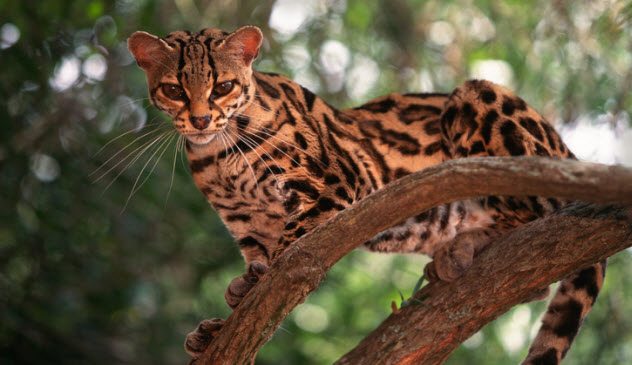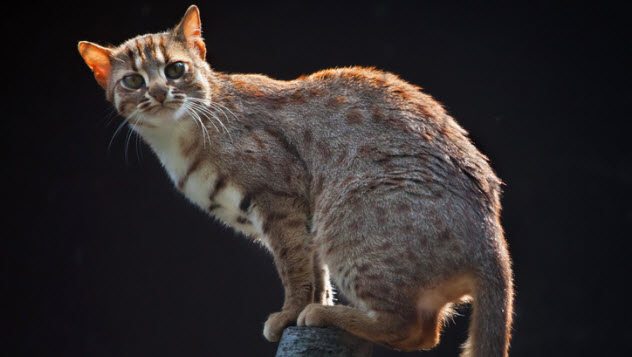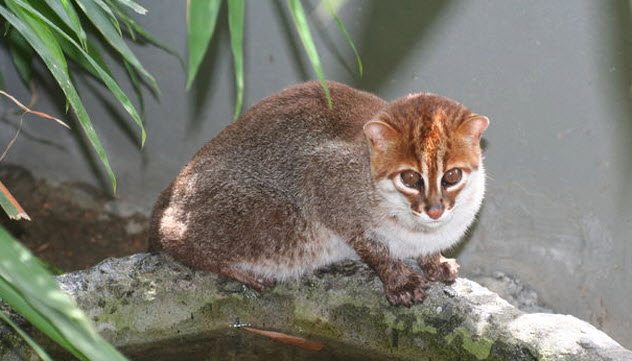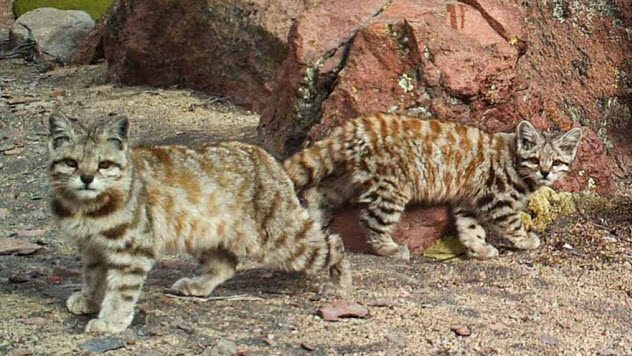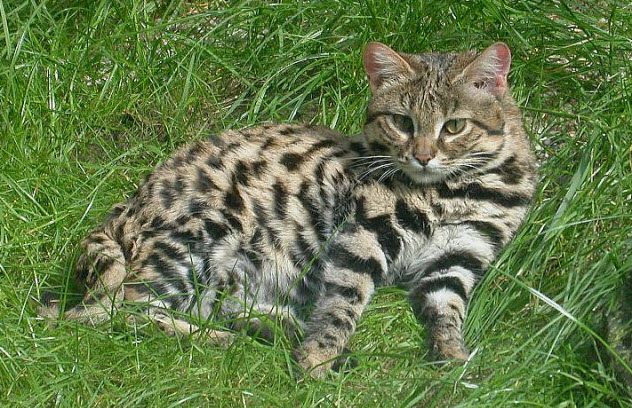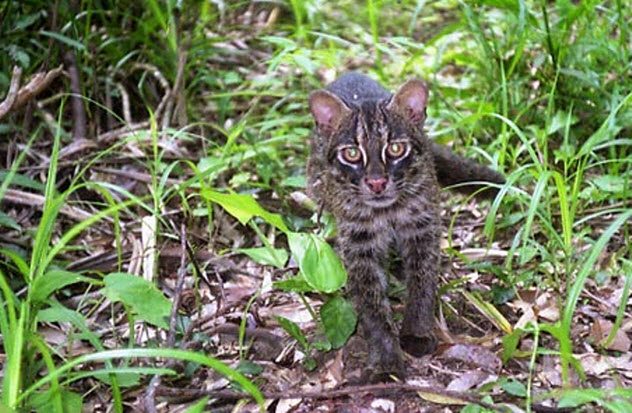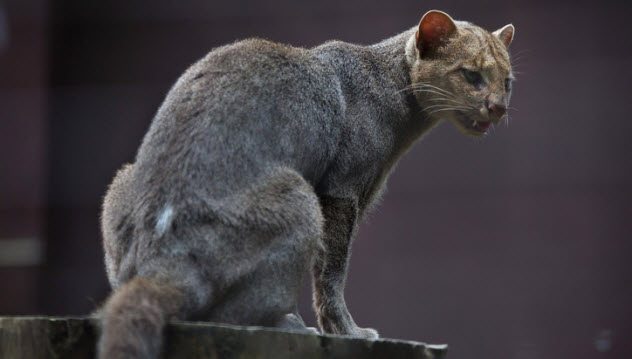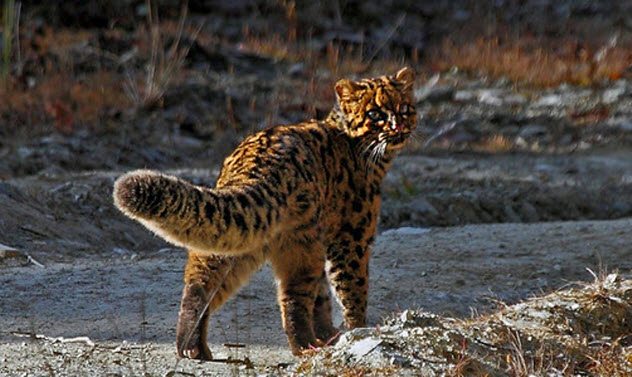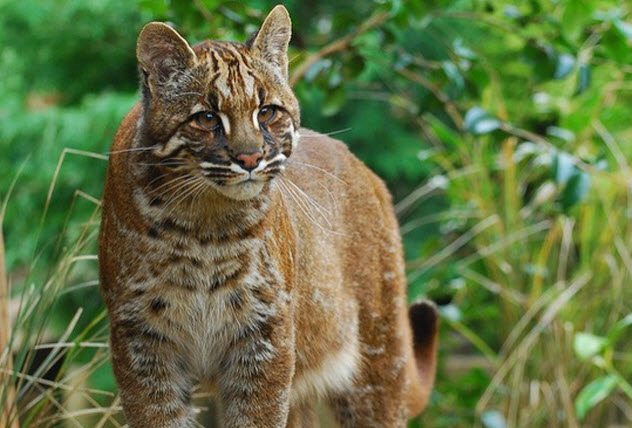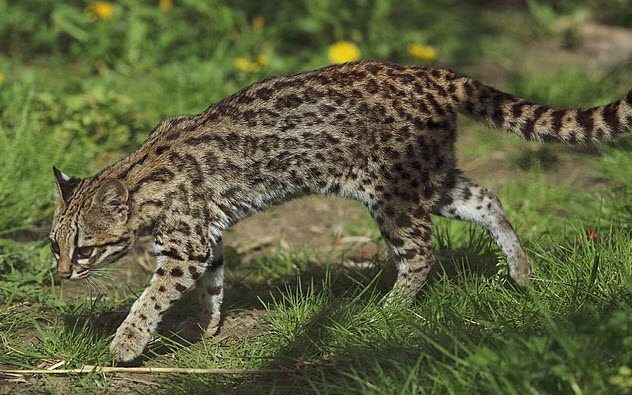Their keen sense of smell, excellent eyesight, powerful hind legs, and small collarbones help them outmaneuver their prey. They are masters of stealth and will creep up on their prey like ghosts. Unlike canines, most cats live and hunt alone. Male felines typically spend little or no time with their young, leaving most of the parenting to the mothers. Many cat species are well-known. From the social and majestic lion to the swift and elegant cheetah, cats have fascinated humans for thousands of years. However, not all cats have received the attention they deserve. Below are 10 little-known cats that will fascinate all of us.
10 Margay
Margays are spotted cats that sport long, ringed tails. These South American felines are true tree huggers. Margays refuse to even go through areas without cover and rarely descend from the trees. They will even birth their young high off the ground. Their main habitat is rain forests, but they will sometimes reside in large coffee, cocoa, pine, or eucalyptus farms. Margays are among the most agile of cats and boast little feline competition in the trees. Their wide feet and nimble toes allow them to hang with one foot underneath a tree branch. These graceful cats can even manage to pivot their feet 180 degrees. As if that wasn’t enough, margays can leap almost 6 meters (20 ft) vertically and can jump 9 meters (30 ft) across.[1] These cats dine on birds, reptiles, and primates. Margays have even been observed mimicking pied tamarin monkey infants in an effort to lure in adults. Margays are solitary and, like humans, typically birth a single offspring. Unfortunately, farms and cities are encroaching on their dwindling habitats. Margay populations are also suffering from illegal pet and fur trades. Unless something is done, these beautiful cats might one day say goodbye.
9 Rusty-Spotted Cat
Rusty-spotted cats are among the smallest cats in the world—even being outweighed by many domesticated cats. True to their name, rusty-spotted cats have a taupe coat speckled with rust-colored markings. They boast white undersides, unmarked tails, and large, round eyes that vary in color. These petite felines call India and Sri Lanka home. They situate themselves near abandoned houses, in forests, on stony foothills, in bushy areas, and in grasslands. Rusty-spotted cats eat small animals, including mice, rats, and chickens. They also supplement their diets with termites and attack bigger game, including the non-native gazelle, if given the chance. Their reproductive life is similar to that of domesticated cats, a species with which they are known to mate. One to three offspring is the common range, but little is known about the rearing process. Rusty-spotted cats are uncommon, with their main threats being dogs, human hunters, and habitat destruction.[2]
8 Flat-Headed Cat
Not much is known about these elusive felines that are aptly named for their flat foreheads. They are similar in stature to a domesticated cat with dark ginger heads, brown fur, and white underbellies. Flat-headed cats have the distinction of consuming more vegetables and fruit than any other cat. However, they are mostly carnivorous and dine on aquatic prey. In fact, the flat-headed cat’s paws boast greater webbing that that of the fishing cat and their claws cannot be fully sheathed. These cats enjoy swimming, and captive kittens have been observed to instantly gravitate to water. Litters typically range from one to four offspring. These unusual felines are highly threatened by habitat loss, illegal trade, and water pollution. But there is still hope for these hydrophilic felines. They are found in Sumatra, Borneo, and Malaysia. In the latter country, they were thought to be extinct until some resilient felines were spotted making their homes in palm plantations.[3]
7 Andean Mountain Cat
Snow leopards are not the only mountain-dwelling felines. Andean mountain cats are thick-coated, gray and yellow-brown tabby cats that are found in the Andes Mountains. They are particular about their habitat requirements and prefer stony, dry areas up to 4,000 meters (13,000 ft) high.[4] These medium-sized, nocturnal cats are not well-known. Little information has been gleaned about their reproductive lives, but we do know that they can birth multiple cubs and sometimes pair up. They dine on mountain viscachas, rodents that bear a striking resemblance to rabbits. These beautiful felines are facing numerous threats. Farmers kill them to protect their livestock, and their cattle gobble up the cats’ land. Mining and hunting have diminished Andean mountain cat populations. They are also killed by locals and used in medicine, for religious purposes, and for food. Unless action is taken, these elusive cats may soon become extinct.
6 Black-Footed Cat
Many interesting and overlooked cat species are quite small. The black-footed cat is the smallest African cat. Their large ears help them to pinpoint sounds, while their black feet protect their paws from the heat. These spotted—and sometimes banded—cats live in the deserts and grasslands of South Africa, Namibia, and Botswana. Although it has not been observed by scientists, natives believe that these felines—which weigh 1–2.5 kilograms (2.2–5.5 lb)—can hunt giraffes! These feisty cats have been known to successfully fight off jackals.[5] Their diet encompasses eggs, amphibians, locusts, rodents, young springbok, reptiles, hares, and birds. Hunting strategies include patiently waiting outside of animal burrows, chasing prey, and leaping up to 2 meters (7 ft) high to capture birds. Mothers have 1–4 kittens, and the cats otherwise live alone. Food poisoning, decimation of their habitat, and dogs are taking a toll on the black-footed cat population. However, with their bold attitudes, these cats have the potential to pull through with some assistance.
5 Iriomote Cat
Iriomote cats are now considered a subspecies of the leopard cat. Their habitat range is restricted to the Japanese island of Iriomote, but they will claim beaches, swamps, low hills, and rivers as their territory. These house cat–sized felines feature dark coats with white spots and golden eyes. These multitalented cats can swim and scale trees. One to four kittens are birthed in tree or rock hollows. Iriomote cats are facing many threats. For one, the islanders consider the felines’ flesh to be delicious. Also, their habitat is being turned into roads, cities, and farms. The Iriomote cats also mate with stray domestic cats, producing hybrid offspring.[6] Wild house cats compete with the Iriomote cats for food, territory, and mates. However, their largest threat is that they are found on only one island, making their population less genetically diverse and restricted in terms of habitat. If something were to destroy the island of Iriomote, these endemic felines would be gone forever.
4 Jaguarundi
Despite their name, these South American felines do not resemble jaguars and are actually related to cougars. Jaguarundis are small cats with slim figures, long tails, stubby limbs, diminutive ears, and coats consisting of black, gray-brown, or red-brown fur. Their habitat is the forests, grasslands, swamps, and scrubland of southern Mexico and a large part of South America. Jaguarundis enjoy a varied diet of rodents, fruit, birds, and reptiles. These day-loving cats sometimes hunt and travel in pairs. They are extremely vocal compared to other cats, making a range of 13 different sounds. They generally give birth to litters with one to four kittens in a secluded area. Unlike many of the other cats on this list, the jaguarundis are currently not facing major population threats. Their fur is not considered fine enough to sell, but they are killed when they hunt poultry.[7]
3 Marbled Cat
Although they’re smaller, marbled cats share a striking resemblance to clouded leopards. Marbled cats live exclusively in the forests of Southeast Asia. However, little information has been gleaned about this mysterious species. With their flexible feet and short limbs, marbled cats are believed to dwell in trees. They are extremely agile. Like the margay, they can swivel their paws. They birth one to four kittens, although little is known about their reproduction.[8] Similarly, little is known about their diets, but it has been suggested that they may eat bats. Their forests are being cut down and transformed into cities and farms. Unless action is taken, the world may never really know about the beautiful and fascinating marbled cat.
2 Asiatic Golden Cat
The thick-furred Asiatic golden cat is known for having black, red-brown, gray, russet, golden-brown, or brown fur. These medium-sized felines are found in forests and rocky areas in Southeast Asia. Not much is known about these rare felines. They spend quite a bit of time on the ground but will occasionally foray into the trees. Females have litters of one to three offspring. Unfortunately, many male Asiatic golden cats have taken their own mates’ lives, making the difficult task of breeding them in zoos all the more complicated. Faced with this problem as well as the fact that some Asiatic golden cats eat their own kittens, scientists tried artificial insemination on one occasion and it successfully produced two kittens. This is all the more valuable due to the many threats facing these felines. They are killed for their pelts and to stop them from eating livestock. Villagers also like to eat these cats. In fact, their flesh is thought to increase strength and their ground-up bones are used to treat fevers.[9] The Asiatic golden cat is a fascinating and complicated cat whose sometimes violent nature renders its protection more difficult.
1 Oncilla
The oncilla is a small, spotted cat that lives in parts of northern South America. These fragile-looking cats should not be underestimated. They are found at elevations as high as 3,600 meters (11,800 ft). They live in forests, in close proximity to humans, and in scrublands, often living in higher densities than other feline species. Oncillas are related to margays but are typically smaller and more terrestrial. Although they are agile and nimble climbers, oncillas prefer to hunt on the ground where rodents, their favorite meal, can be found.[10] One to three kittens can be born to a female, who sometimes encounters hostile males. Their recorded life span of 23 years in captivity makes them longer lived than many felines. The oncilla is threatened by the competition from larger cats. But the greatest dangers come from humans in the forms of habitat loss, fur trade, and the exotic pet trade. The oncilla has proved to be resilient and can even live on coffee plantations, so there is hope for these tiny bundles of beauty. Alexandra is fascinated by animals and loves writing, reading, and spending time with her guinea pig, Chestnut.
